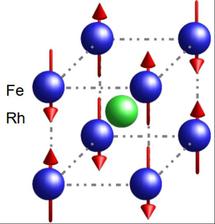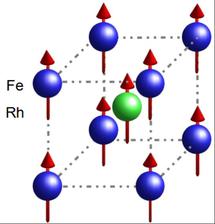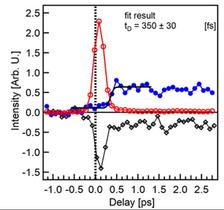FeRh structure and magnetic moments in the anti-ferromagnetic phase (partly from original publication).
Spintronics, the manipulation of electron spins and magnetic moments, is aimed at supplying an alternative to conventional electronics technology which uses the change of electronic states to store and transfer information using binary bits. At FLASH, an international research team, including the Central European Institute of Technology (CEITEC) in Brno (Czech Republic) and the University of Mainz, has now addressed the problem of ultrafast generation of magnetic ordering in a possible candidate for the realisation of spintronic devices. To solve this question, they combined time-resolved soft X-ray photoemission with state-of-the-art time-dependent Density Functional Theory (DFT) calculations.
This system, a magnetic FeRh binary compound, shows a first order phase transition from an anti-ferromagnetic (AFM) to a ferromagnetic phase (FM) at about 100 K above room temperature. In the AFM state, Fe atoms alone carry a net magnetic moment which is oppositely aligned. In the FM state Fe moments align parallel to each other and a net magnetic moment is induced in the Rh atoms. The strong magnetic effect is also influencing the electronic structure of the system, resulting in a spin polarisation in the valence band. This spin polarisation makes the system appealing for the development of spintronic devices. It offers the possibility of spin pumping in magnetic hetero-junctions in which a spin current or spin accumulation is generated at the interface between the two layers.
The team investigated the role of electronic structure and charge transfer in the FeRh order phase transition by combining time-resolved soft X-ray photoemission results achieved at FLASH with time-dependent Density Functional Theory (DFT) calculations. To contribute to long-debated discussion on this phase transition, a unique combination of techniques was required, available at the FLASH beamline PG2. An ultrafast optical pump laser excited the samples, which were ‚probed‘ by an ultrafast soft X-ray pulse, and the HEXTOF endstation was used as a momentum microscope. HEXTOF merges three photoemission spectroscopy techniques into a single setup for analysis of photoemitted electrons.
The studies showed that an ultrashort laser pulse can indeed induce a first order phase transition. Consequently, the magnetic moments switch from an anti-parallel to a parallel configuration. The evolution of the electronic state of FeRh during this transition was measured with femtosecond temporal resolution. For the interpretation of the experimental results, the collaboration with two teams of the European Theoretical Spectroscopy Facility (ETSF), based in Rome and Paris, was important. The interpretation of the experimental results revealed that the Optical Inter-Site Spin Transfer (OISTR), namely the ultra-fast ‘electron charge and spin transfer’ from Rh atoms to Fe atoms is the most suitable candidate as a trigger for the phase transition. Furthermore, it can be shown that the time-scale of the induced phase transition is on the order of (a) few hundreds of femtoseconds (10-15 s).
This result will foster the understanding of the fundamental triggers of electronic and magnetic phase transitions as well in other systems with similar behaviors such as topological insulators or cobaltites. Spin and charge transfer, where electronic and magnetic degrees of freedom are strongly correlated, are probably playing a more important role in ultrafast dynamics than previously expected. Future technologies will be based on the controlled manipulation of the electron spin which may open the pathway towards higher storage density memories, faster switching speed and more efficient power use.
Reference:
F. Pressacco, D. Sangalli, V. Uhlíř, D. Kutnyakhov, J. A. Arregi, S.Y. Agustsson, G. Brenner, H. Redlin, M. Heber, D. Vasilyev, J. Demsar, G. Schönhense, M. Gatti, A. Marini, W. Wurth, F. Sirotti, Subpicosecond metamagnetic phase transition in FeRh driven by non-equilibrium electron dynamics, Nat. Commun. (2021), DOI: 10.1038/s41467-021-25347-3









